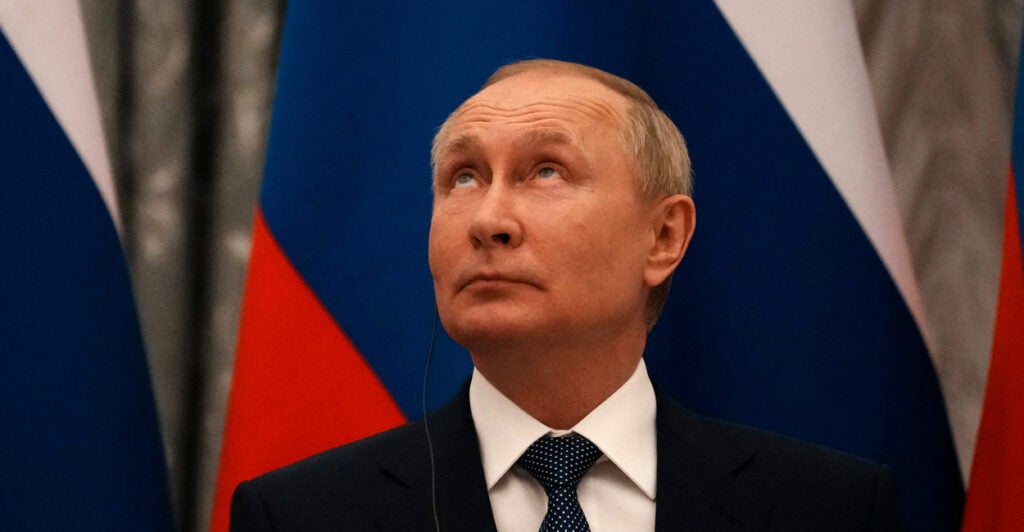Russian President Vladimir Putin on Sunday morning ordered his military leaders to place nuclear forces on high-alert status during his war on Ukraine.
We don’t know the details of what Putin’s order entails. Many of Russia’s strategic nuclear forces that can reach the U.S. already are kept on a high level of alert.
This new action could mean a variety of changes, from preparing to arm tactical missiles with nuclear weapons, to deploying more nuclear forces at sea, to dispersing mobile missiles.
We also can’t know the true intentions of Putin, who seems to behave more recklessly by the minute.
But what we do know is that the Russian president’s move is unjustified, highly provocative, and yet another reminder of the relevance of strong nuclear deterrence.
To start, placing nuclear forces on higher alert is aggressive and reckless when Russia’s security has not been threatened. Unjustifiably invading a sovereign nation and proceeding to threaten the use of nuclear weapons when the invasion doesn’t succeed is hardly a reason to resort to the world’s most dangerous weapons.
Yet unfortunately, Putin’s nuclear saber-rattling is not new. Just days before Russia invaded Ukraine, Russia conducted massive nuclear drills that entailed practice launches of ballistic and cruise missiles.
Earlier in February, Putin issued a subtle nuclear threat by reminding the West that should Ukraine join the NATO alliance, “Russia is one of the leading nuclear powers and is superior to many of those countries in terms of the number of modern nuclear force components.”
Not to mention that Russia maintains a stockpile of more than 2,000 tactical nuclear weapons that it incorporates into its basic warfighting strategy. In fact, this latest nuclear provocation aligns with Russia’s dangerous “escalate to win” doctrine, where Moscow reserves the right to use nuclear weapons in an escalating conventional fight to compel an opponent to back down.
This is not to imply that Americans should panic over an impending nuclear war. Launching nuclear weapons—whether at Ukraine or recklessly into NATO countries—likely would not help Putin achieve his goals. Doing so only would intensify the already strong international response, if not provoke a NATO nuclear response on Russian soil.
Putin likely is turning to nuclear threats because he sees that conventional conflict is not achieving the outcome he wants. Ukrainians have been repelling attacks successfully as the international community rallies behind Kyiv.
With no intention of accepting failure, Putin must attempt to signal to the world Russia’s strength.
But there are also reports that say Putin has become “unhinged”—seemingly paranoid and irrational compared to his usual demeanor. And in the fog of a war between sovereign nations in 21st-century Europe that might have been unthinkable just a few months ago, anything could happen.
The West must continue to push back against Putin’s murderous war on an innocent country while considering offramps to back Putin down from his nuclear cliff.
Russia’s actions, however, remind us why maintaining a strong nuclear deterrent is so important. For years, the United States had neglected its nuclear forces under the assumption that nuclear war would remain a relic of the Cold War.
Now, the U.S. is scrambling to modernize nuclear missiles and warheads that were built dozens of years ago and are aging into obsolescence.
In the upcoming Nuclear Posture Review, it is critical that the Biden administration commit to seeing the U.S. nuclear modernization program through, to ensure we credibly can deter nuclear threats for decades to come.
The administration also must reject pressure from the left to cut any U.S. nuclear capabilities. Putin’s order to place Russia’s nuclear weapons on higher alert should make it clear that now is not the time to risk weakening American nuclear deterrence.
As demonstrated in this conflict, and conflict through the centuries, weakness in the face of aggression never prevails.
As we learned over the weekend, nuclear threats are real and nuclear war is a 21st-century concern. Moving forward, the Biden administration must ensure a U.S. nuclear posture that accounts for the increasing relevance of nuclear deterrence in the face of this dangerous reality.
Have an opinion about this article? To sound off, please email letters@DailySignal.com and we’ll consider publishing your edited remarks in our regular “We Hear You” feature. Remember to include the url or headline of the article plus your name and town and/or state.
